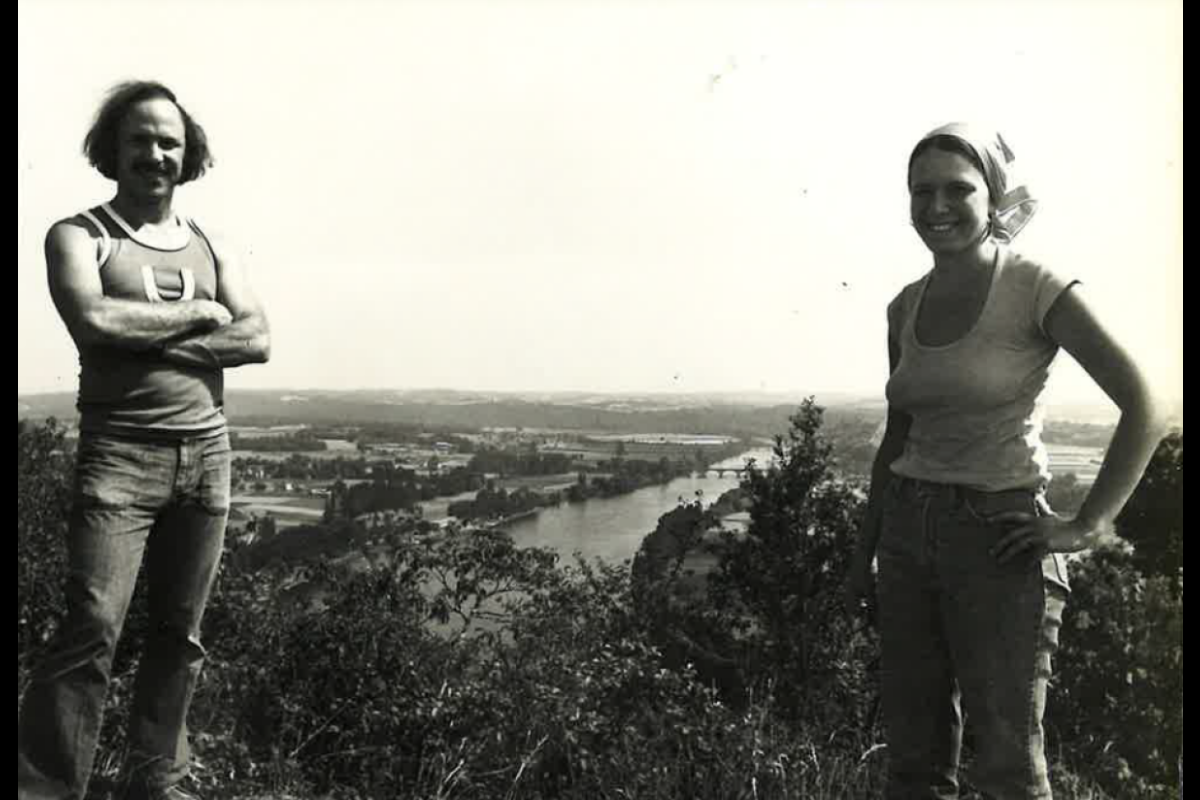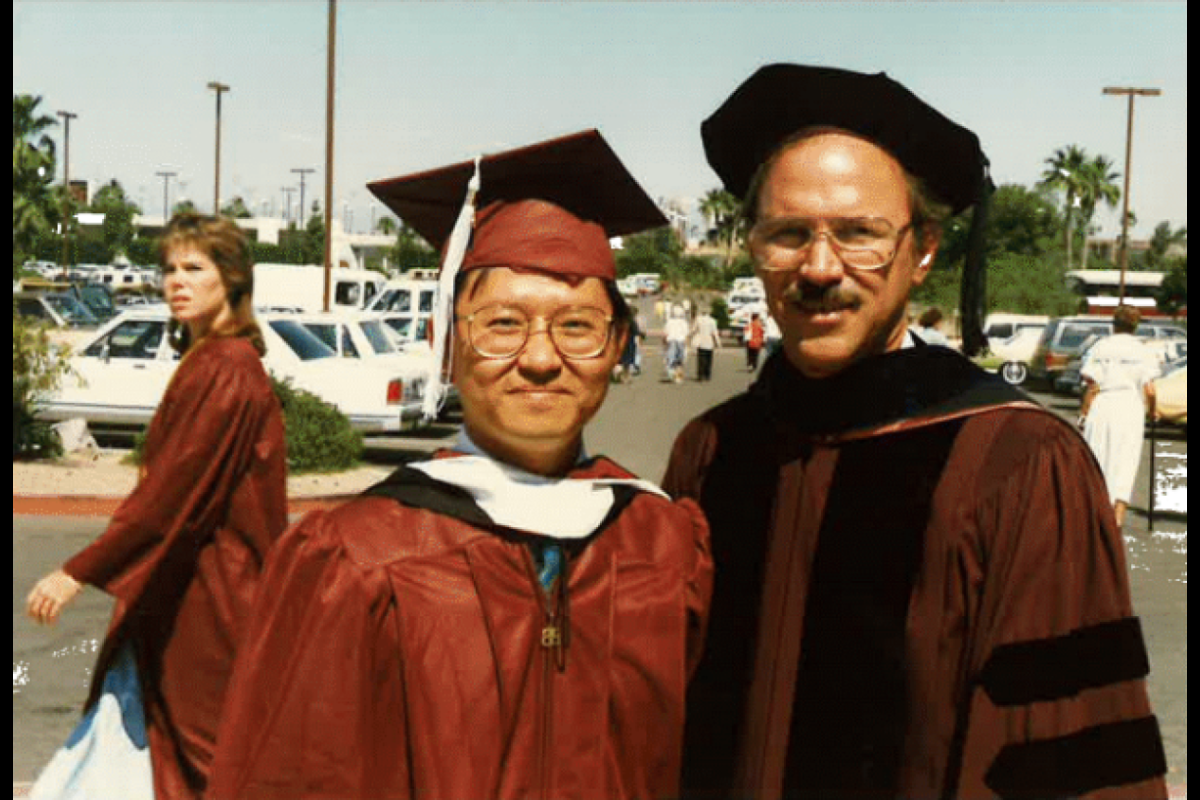Charles Redman, founder of the School of Sustainability, faces a new adventure: Retirement

Charles Redman congratulates the first School of Sustainability graduate, Brigitte Bavousett, in 2007. Photo courtesy of the School of Sustainability
At the retirement celebration for Charles Redman on Oct. 22, two messages persisted: Redman’s contributions to Arizona State University helped to shape the interdisciplinary efforts we now find synonymous with ASU, and those close to him know better than to expect him to lead an uneventful retirement.
The event also marked the launch of a new $100,000 endowment from Redman and his family, which will go toward graduate student research in the School of Sustainability, an academic unit of the College of Global Futures.
As the founding director of the Global Institute of Sustainability in 2004, soon followed by the launch of the School of Sustainability in 2006, Redman was instrumental in creating the blueprint for a quality sustainability education. The school was the first of its kind in the world and set an important precedent for the role of higher education in tackling our world’s greatest challenges.
Many things have changed since Redman donned his graduation regalia to congratulate the School of Sustainability’s first graduate, Brigitte Bavousett, in 2007.
ASU has included sustainability education in its core curriculum requirements; is repeatedly ranked No. 1 for its sustainability impact; and is making strides to go further in its sustainability efforts — aiming to be Zero Waste by 2025.
And according to the ASU Alumni Association, more than 3,000 Sun Devils have graduated from the School of Sustainability, with an 86% employment rate.
An emerging leader in an undefined field
Redman himself is no stranger to change. As a teenager, he did not aspire to be a leader in the sustainability space — such a thing was unheard of at the time. A young Redman had wanted to be an engineer. He obtained his bachelor's degree in physical sciences from Harvard in 1967.
A surprising enthusiasm for archaeology had emerged in between his engineering courses, and Redman found himself at a crossroads when applying for graduate school. After volunteering at an archaeological dig, his mind was made up: He would continue his education in archaeology.
Following the completion of his master's degree and PhD, Redman taught at New York University and at SUNY-Binghamton before coming to Arizona in 1983. The decision to move to Arizona was a practical one. He and his wife were expecting a child, and it was important to be able to come home from archaeological digs every night instead of traveling to a dig site for weeks at a time. Redman found Arizona’s archaeology to be interesting, and a promising position had just opened at ASU.
“After a few years, I became the chair of the Department of Anthropology. I hadn’t imagined myself in that role, but I kind of found myself in the position, and I think people were OK with me doing it,” Redman said with a laugh. “If they weren’t, they were kind enough to let me carry on with it.”
In conversation with Redman, it quickly became apparent why he has been so widely liked by his colleagues: Although he possesses an extensive history of impactful work in his field, he spoke even more easily of his relationships with others. His fondness for his colleagues came through clearly in his descriptions of previous projects and initiatives, but particularly in his reflections of his lasting impact on ASU.
“Honestly, I think the most important thing I’ve done at ASU, both in anthropology and in my sustainability work, was to be involved in the hiring and mentoring efforts,” he said. “I’m proud that I was able to welcome such talented people to ASU who themselves have contributed so much to the university. Today, I’m thankful to call many of them friends.”
Redman served nine years as chair of the Department of Anthropology, during which time he developed an interest in how to apply his anthropological studies to the future — in the years beyond, how would people adapt to their surroundings, move across spaces and impact their environments? What would the future look like? This curiosity made him a natural fit to direct the Center for Environmental Studies when an opening arose.
It was in this role, which he held for seven years, that Redman met a consultant from Columbia University who was invited by ASU’s provost office to serve as an advisor on special issues. This consultant had a sharp eye for the value of sustainability, and he took an interest in the Center of Environmental Studies. This consultant was Michael M. Crow.
A few years after Crow officially joined ASU as university president, he tasked Redman with both launching and directing the Julie Ann Wrigley Global Institute of Sustainability in 2004 (now known as the Global Institute of Sustainability and Innovation).
“Michael Crow saw sustainability as both an opportunity and a universitywide objective," Redman said. "Michael spoke to me and the vice president of research at the time, Jonathan Fink, and he essentially said to us, ‘You two will create the sustainability institute at ASU. You’ll create a school, you’ll involve people from other colleges. Let’s get it done.’ And we did.”
Crafting the School of Sustainability required extensive discussions ranging from curriculum to the name of the school itself. Would the school be housed within ASU’s existing framework for engineering, architecture or life sciences? After deliberation, the vast range of the field made it clear that it could not live under just one umbrella. Even the name of the school, a seemingly simple one, was hotly debated.
“The engineers felt that it shouldn’t be ‘sustainability science’ but the scientists felt ‘sustainability studies’ was too soft, but most everyone agreed that we didn’t want to limit sustainability to just one area,” Redman said. “We wanted to keep it open to everything, including the humanities, and the best way to do that was to keep it as just ‘School of Sustainability.’ It took a lot of back and forth to land on the name you now know.”
The School of Sustainability launched with a unique dedication to interdisciplinary solutions. Its holistic approach was nonnegotiable for Redman, who said that academia at the time took a much more narrow approach to solutions. In the years since 2006, Redman said, interdisciplinarity has become more and more common at universities. So too, has sustainability education and efforts worldwide. Redman said he is honored to have played a part in it all.
A heartfelt send-off, happy tears and jokes
On Oct. 22, Redman was joined by his friends, family and colleagues to celebrate his 41 years at ASU. The event did not have a shortage of attendees. The send-off was held in the auditorium of the Walton Center for Planetary Health, and a group photo of the attendees spanned across the entire width of the auditorium’s stage.
Christopher Boone, currently a professor in the School of Sustainability, led the event. Formerly the dean of the School of Sustainability and the founding dean of the College of Global Futures at ASU, Boone said Redman led ASU faculty and staff through a time of both unbridled possibility and uncertainty.
“I’m sure you remember that some people thought we were crazy, they thought we would fail miserably, that ‘sustainability’ was a buzzword that didn’t have staying power,” Boone said at the event, directly addressing Redman. “Your ability to lead us through that doubt was crucial, and from there, we were able to demonstrate the value of sustainability as an existential issue that we need to face. So I want to thank you very much for getting us to where we are today, because we've become the envy of sustainability programs worldwide.”
Joshua Abbott, the current director of the School of Sustainability, was the second-ever faculty member hired fully into the school in 2007. A recent PhD graduate at the time, Abbott recalled his amusement at his office, then located in a converted grocery store, only having half of a wall. Now located in the Walton Center for Planetary Health, the School of Sustainability has a much more updated home.
“The legacy that you have left, both in terms of the intellectual direction of the school, but also the culture of the school and the way that we do what we do, cannot be underestimated,” Abbott said to Redman. “And when I think back to those early days in the school … and some of the things that are really in the DNA of the school now, it is really reflective of your leadership.”
As Redman closed out the event, his final thanks were simple: “I want to thank everyone for their kind words, and for being great.”
More Environment and sustainability

Driving green desalination
Wilderness survival TV show hosts, pirates and water treatment researchers agree on one thing: Most natural water sources are not safe for drinking. Among the many potential risks is the high salt…

ASU preservation facility serves as test bed for rooftop heat mitigation
A roof coating that uses thermal energy storage materials from Arizona State University spinout EnKoat is halting the heat in several ASU buildings — including a section of the university’s largest…

ASU Carbon Summit displays sustainability leadership, collaboration and ... electric motorcycles
This month, a student-led initiative brought government officials, entrepreneurs and nongovernmental organizations under one roof to discuss sustainable carbon solutions. The annual Carbon…


